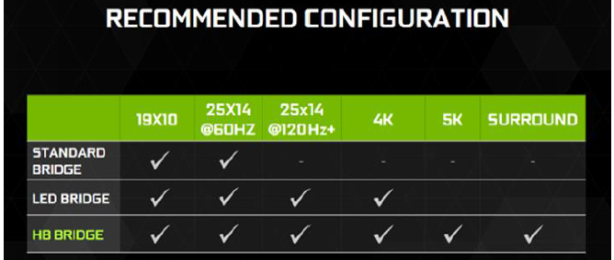Two at a Time: Multi-GPU and SLI Update
There has been a fair bit of confusion surrounding the GTX 1080's SLI capabilities since it launched. The truth of the matter, in short, is that you can pair up three or four GTX 1080s in a system should you wish, but they are going to have very limited uses. Two-way SLI is the only true SLI mode properly and officially supported out of the box. The below text expands upon this in greater detail.With DirectX 12, Microsoft implemented changes that affect the way multi-GPU setups can work, the main idea being to give more control to developers by making applications aware of multiple GPUs instead of hiding them under the driver layer. Nvidia supports three different multi-GPU modes now with DX12: multi-display adaptor (MDA), implicit linked display adaptor (LDA) and explicit LDA.
In MDA mode, you can combine and utilise any number of any display adaptors you pick. It allows groupings of mismatched cards, even when they're from different vendors. In theory, you could have Intel integrated graphics, one AMD card and one Nvidia card all operating together on a single app. This sounds great, of course, but remember operating is very different to operating efficiently. Each GPU is presented to the application as a single adaptor, but they are logically distinct and cannot share resources. It is also fully up to the application how it manages these GPUs. Ashes of the Singularity uses this mode, and any game promising multi-vendor support is likewise utilising DX12's MDA mode.
Both LDA modes, meanwhile, rely on the GPUs being matched, which allows them to share memory resources and work together to a degree – the game or app sees only a single adaptor. With LDA Implicit, this functionality is handled by Nvidia, and it's this mode that the term SLI officially refers too. On the other hand, with DX12's LDA Explicit mode, the responsibility of leveraging the shared resources of matched GPUs again falls on the developer – as we said, DX12's multi-GPU possibilities are all about giving developers more control.
With Pascal, Nvidia is now officially only supporting two-way SLI in the vast majority of circumstances. Nvidia says this is in response to the changing ways that games are being developed, specifically highlighting CPU bottlenecks and the use of inter-frame dependencies (i.e. using data from a previous frame to render the next one quicker) as issues that make scaling tricky, and scaling beyond two GPUs extremely complex. While it wasn't outright said, there's also the issue that 3-way and 4-way setups are very niche, so piling resources into making them work efficiently is unlikely to be very cost-effective. Now, these resources will be put into making two-way SLI more effective.
At launch, Nvidia claimed that 3-way and 4-way SLI modes would be supported, but not out of the box. Users would have to go to a website, register their hardware and get an 'Enthusiast Key' to unlock the functionality. However, since then Nvidia has retracted this statement, as reported by PC Perspective. In truth, these SLI setups will not be supported by Nvidia at all, except in very specific situations, namely in synthetic benchmarking software used by extreme overclockers, presumably so Nvidia maintains a presence in this scene. Support for these should come in a driver update – the Enthusiast Key idea seems to have been scrapped altogether. Theoretically, a two-way SLI setup with a third GTX 1080 as a PhysX GPU would also count as an officially supported configuration, but otherwise that's it from Nvidia's end.
The new DX12 multi-GPU possibilities only add to the confusion: in theory, developers can support 3-way and 4-way GTX 1000-series setups by leveraging various techniques in the MDA or LDA Explicit modes. However, with no games like this currently in existence (Ashes only supports two GPUs) and anything beyond 2-way Pascal setups being useless for all pre-DX12 games, the motivation for developers to implement the support is virtually non-existent. In summary, if you're not an extreme overclocker, don't order more than two GTX 1000-series cards.
The final thing related to SLI is the introduction of new two-way SLI HB bridges, where HB stands for high bandwidth. You may be aware that GTX 1080 cards still have two SLI connectors, and the new bridges now link these to boost the available bandwidth in a two-way setup. The connectors haven't changed physically, so support for older bridges is maintained, but they will limit the data exchange rate between the GPUs – the new high bandwidth bridges (and the previously released LED bridges) boost the interface speed from 400MHz to 650MHz with Pascal, more than doubling the available bandwidth (dual-link plus higher speed). The aim is to deliver a smoother experience through lower frame times on displays with high bandwidth requirements. While you can use these monitors with any setup, the new bridges supply enough bandwidth to stop data having to be transferred over PCI-E when the SLI bridge runs out.

MSI MPG Velox 100R Chassis Review
October 14 2021 | 15:04











Want to comment? Please log in.